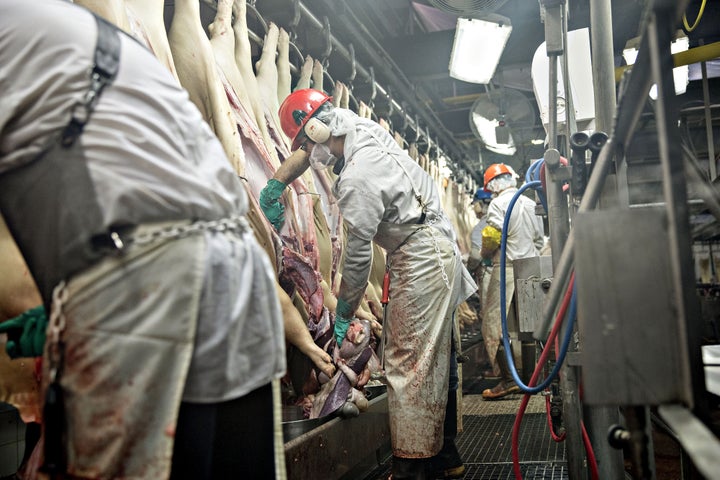
The U.S. Department of Agriculture is pushing forward with a proposed rule that would forego line-speed limits in hog processing plants, a move that could endanger the well-being of workers and consumers, activists say.
The proposal is part of the USDA’s effort to “modernize” the swine industry, the organization announced earlier this month. These plants, which already work at feverish speeds of up to 1,106 hogs per hour, would likely use the change as an opportunity to further increase the pace of production.
In addition to increasing line speeds, the proposal would allow employees to take over some of the oversight duties that USDA inspectors currently handle on the kill lines.
The way it works now, USDA inspectors are expected to examine every animal that comes down the line, and are tasked with identifying diseased hogs and visible fecal matter. Under the proposed rule, plant employees would take over that job before the carcasses reach federal inspectors.
The move could potentially help the hog industry’s bottom line. But faster speeds could also put consumers at risk, since inspectors may not be able to examine each carcass adequately for diseases and other issues. Increasing the rate of speed lines could present more risks for plant workers who already face a slew of hazards at the industry’s current pace, including amputations and musculoskeletal injuries, such as carpal tunnel syndrome.
But the USDA maintains that it’s not its responsibility to ensure worker safety ― that’s up to the Occupational Safety and Health Administration, said Carmen Rottenberg, deputy administrator at the Food Safety and Inspection Service at USDA.

The proposal is “a gift to the industry,” said Tony Corbo, senior lobbyist with Washington-based advocacy group Food & Water Watch. “The industry has been pushing to deregulate inspection all the way back to the Reagan administration.”
Corbo added that while the proposed rule fits in with the Trump administration’s “deregulatory talk,” the concept actually precedes the current presidency.
During the Obama administration, the USDA approved a similar plan for poultry plants in 2014. But after getting bombarded with pushback from activists and the media, the government organization decided to prohibit plants from ramping up the speeds on slaughter lines.
Rottenberg told HuffPost that the revised protocol would increase efficiency and free up USDA inspectors to perform other tasks around the hog plants.
The organization pointed to the “success” of a pilot program that started in the late 1990s, which allowed five hog plants to operate as their own designated speeds.
“For large-volume establishments, this new swine inspection system does make better use of the agency’s resources while also removing unnecessary regulatory obstacles to industry,” said Rottenberg.
But a 2013 report from the Office of the Inspector General harshly criticized the USDA for its lack of oversight of pork slaughterhouses in general, and took issue with the five plants involved in the pilot program in particular.
The report concluded that between 2008 and 2011, three of the 10 plants with the most citations for food safety and animal welfare violations were part of the USDA pilot program. Those plants, which had 50 percent more citations than the plant with next highest number, continue to run at the same speeds.
Workers’ advocates also say that faster line speeds will make an already dangerous job even more dangerous.

Serious injuries ― those that require work restrictions or days off from work ― are more than three times higher in meat packing than other U.S. industries, according to the Bureau of Labor Statistics.
While protecting workers is not within the USDA’s regulatory purview, activists say that workers at slaughterhouses – who are often refugees and immigrants that are reluctant to speak up about hazardous conditions ― rely on USDA’s rules to keep them safe.
“Food safety regulations have acted as a de facto throttle on line speeds, and has consequently protected workers,” said Nicole Civita, a lawyer, professor, food ethicist and director of the Food Recovery Project.
Before moving forward with the proposed rule, the USDA will accept comments from the public for 60 days, through mid-March. Earlier this week, the USDA rejected a petition from the National Chicken Council requesting that poultry processing plants be allowed to do away with line speed maximums.
Activists say there’s no difference between the poultry and hog industries: If the USDA rejected the idea of increasing line speed for chickens, they should also reject it for hogs for the same reasons.
“Do people really want to eat meat that has not been properly processed? What if they find toenails in their hot dogs, or if hogs were diseased and haven’t been caught because the lines are moving so fast?” Corbo said. “Operating at these excessive line speeds without having adequate inspection will put more product into commerce [and] on people’s tables that are unsafe and not wholesome to eat.”
